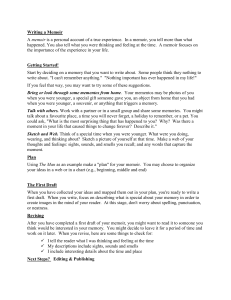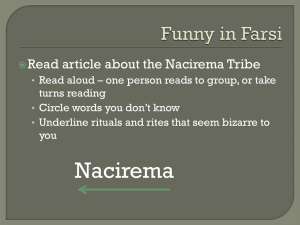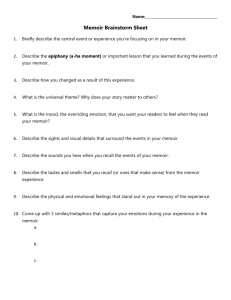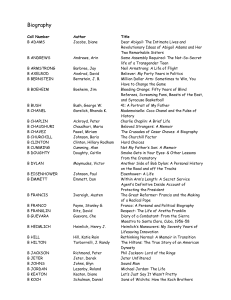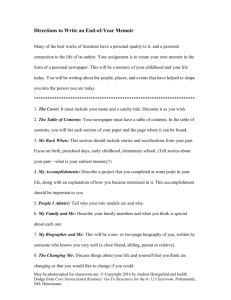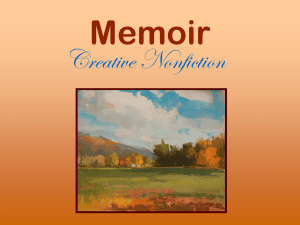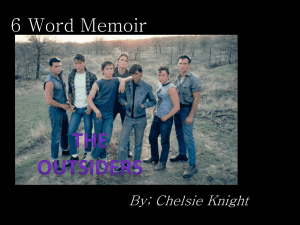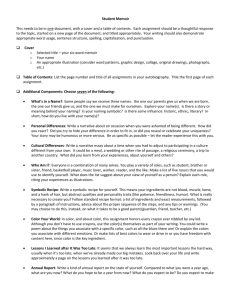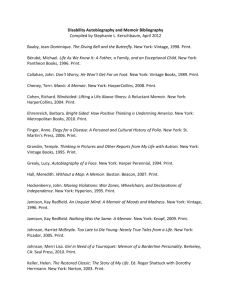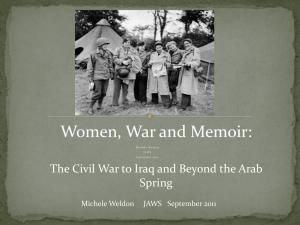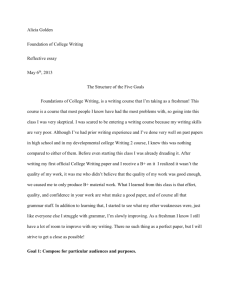Crafting Memorable Memories into a Multimedia Memoir
advertisement
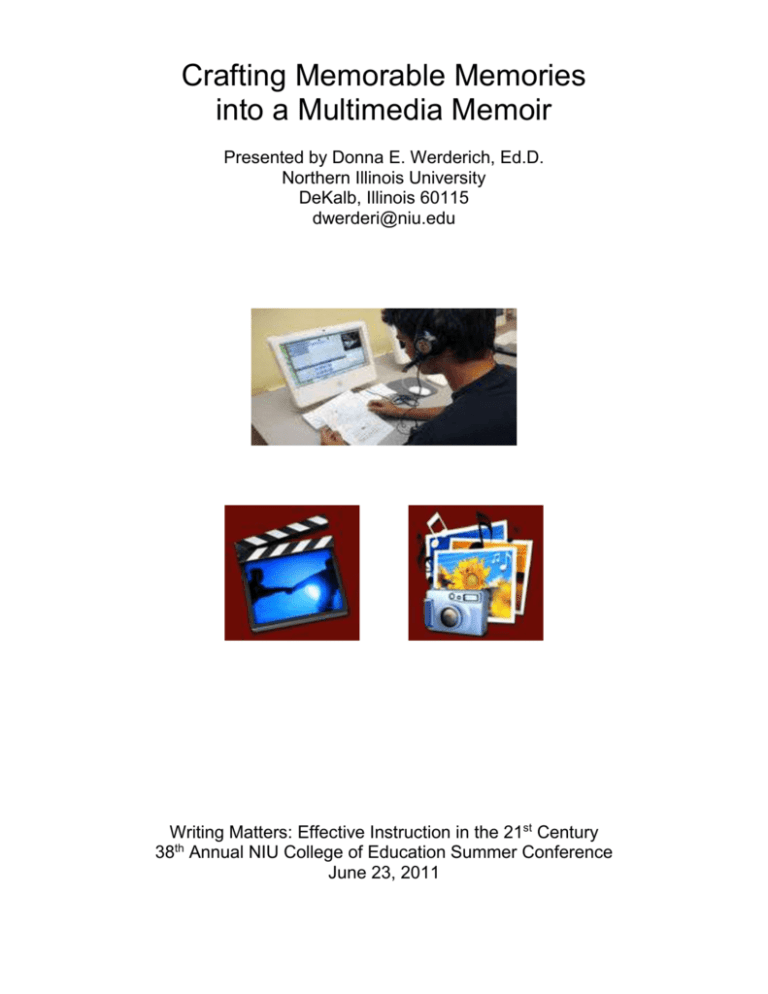
Crafting Memorable Memories into a Multimedia Memoir Presented by Donna E. Werderich, Ed.D. Northern Illinois University DeKalb, Illinois 60115 dwerderi@niu.edu Writing Matters: Effective Instruction in the 21st Century 38th Annual NIU College of Education Summer Conference June 23, 2011 1. What’s a Memoir? “Reading aloud IS teaching writing, even if no writing activity follows the reading.” ─ Vicki Spandel A. Model Texts: Try reading one of these model texts to support students’ understanding of a memoir. Marshfield Dreams: When I Was a Kid by Ralph Fletcher When I was Young in the Mountains by Cynthia Rylant Shortcut by Donald Crews Guys Write for Guys Read: Boys' Favorite Authors Write About Being Boys by Jon Scieszka When I Was Your Age edited by Amy Ehrlich 2. Capturing Memorable Memories • Writer’s notebook: – Lists, wonderings, observations, questions – Heart Mapping and Writing Territories (Atwell, Fletcher) – Quick writes (Rief) – Photo Prompts – Memorable Moments Chart (Werderich & L’Allier) Memorable Moments What I Learned about Myself or Others . . . with my family . . . with my friends . . . when I learned to do something . . . of places I’ve been 3. Pretelling: Tell It Twice (Source: Rog, L. J. Marveolus minilessons. (2011). 1. 2. 3. 4. Select a topic. Tell partner your story, or ideas/topic for piece of writing. (3 minutes) Invite questions and feedback from partner. Work with a new partner to tell the same story/idea again. pg. 2 4. The Process of Developing a Multimedia Memoir Paper Process Pre-writing: brainstorming, researching, outlining Drafting: creating memoir Revising: rereading to modify word choice, organization, and sentence fluency Editing: proofreading for correct conventions Publishing: printing final product Digital Process Pre-writing: collecting images, outlining, and storyboarding Drafting: narrating memoir Revising: modifying narration, images and organization Editing: timing, images, and narration Publishing: viewing final product 5. Focus on Craft: Narrative leads (Atwell) Invigorating your verbs (Fletcher) Dialogue Peer Editing and Conferencing 6. Celebration of Publication: Authors’ House Consider a slightly different version of author’s chair by creating periodic “authors’ houses” during the school year (Werderich, 2008). Fall=Cider House; Winter=Hot Cocoa House; Spring=Lemonade House Guidelines for Responding to the Author Praise something specific the author did well. Refer to the specific place in the memoir that illustrates the strength. Ask the author a question. Tell the author your favorite part. Share how you connected to the author’s story. 7. Evaluation 4 3 2 1 Point of View Strong awareness of audience in the design. Students can clearly explain why they felt the vocabulary, audio and graphics chosen fit the target audience. Some awareness of audience in the design. Students can partially explain why they felt the vocabulary, audio and graphics chosen fit the target audience. Some awareness of audience in the design. Students find it difficult to explain how the vocabulary, audio and graphics chosen fit the target audience. Limited awareness of the needs and interests of the target audience. Dramatic Question Realization is dramatically different from expectation. Realization differs noticeably from expectation. Realization barely differs from the expectation. Realization and expectation do not differ. Voice - Pacing The pace (rhythm and voice punctuation) fits the story line and helps the audience really "get into" the story. Occasionally speaks too fast or too slowly for the story line. The pacing (rhythm and voice punctuation) is relatively engaging for the audience. Tries to use pacing (rhythm and voice punctuation), but it is often noticeable that the pacing does not fit the story line. Audience is not consistently engaged. No attempt to match the pace of the storytelling to the story line or the audience. CATEGORY pg. 3 Soundtrack - Emotion Music stirs a rich emotional response that matches the story line well. Music stirs a rich Music is ok, and not emotional response that distracting, but it does not somewhat matches the add much to the story. story line. Music is distracting, inappropriate, OR was not used. Economy The story composition is typically good, though it seems to drag somewhat OR need slightly more detail in one or two sections. The story needs extensive editing. It is too long or too short to be interesting. The story is told with exactly the right amount of detail throughout. It does not seem too short nor does it seem too long. The story seems to need more editing. It is noticeably too long or too short in more than one section. 8. Resources for Designing and Publishing Multimedia Memoirs Websites www.educationoasis.com/LP/LA/memorir_stuff_life.htm www.emints.org/ethemes/resources/S00001109.shtml www.search.eb.com/women/studyguide/teach6.htm Resources How to write your life story by Ralph Fletcher Notebook Know-How: Strategies for the Writer's Notebook by Aimee Buckner and Ralph Fletcher Shimmering Images: A Handy Little Guide to Writing a Memoir by Lisa Dale Norton Hardware Microsoft Photo Story 3: One of the most widely used software programs used to create digital stories on PCs; especially good for beginners. iMovie: A good choice for Mac users who want to create digital stories. This digital movie creation and editing program has most of the same features as Photo Story, however, it also supports the use of full-motion video clips. Windows Movie Maker: Windows Movie Maker is a video editing software application that has been included as part of the Windows operating system since 2000. Music Sources Sound Effects Sources Graphics Sources Magnatune FindSounds Flickr (magnatune.com/today) (www.findsounds.com) (www.flickr.com) Freeplaymusic. Partners in Rhyme Stock.xcchng (www.freeplaymusic.com) (www.partnersinrhyme.com/pir/PIRsfx.html) (www.sxc.hu) Creative Commons. Nature Sonys Free Foto creativecommons.org (naturesongs.com) (www.freefoto.com) American Rhetoric (www.americanrhetoric.com) pg. 4
